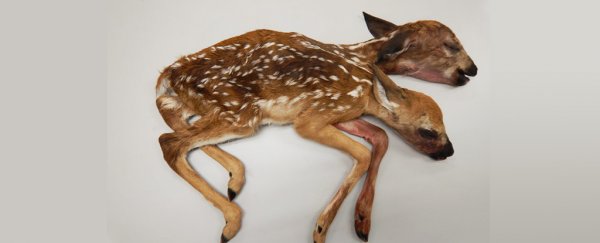Sometimes mushroom hunting can yield much more than you bargain for. In the case of a forest delver in Minnesota, the discovery was straight out of a twisted tale on mutant creatures - a deceased, two-headed deer fawn.
"It's amazing and extremely rare," says deer ecologist Gino D'Angelo of the University of Georgia, formerly of the Minnesota Department of Natural Resources, who studied the tiny carcass.
"We can't even estimate the rarity of this. Of the tens of millions of fawns born annually in the US, there are probably abnormalities happening in the wild we don't even know about."
These fawns turned out to be conjoined twins - the first of their kind known to have been carried to term and birthed. All other examples of such conjoined twins have only ever been seen in utero.
Conjoined twins are more common in domesticated animals, such as sheep and cows, and even kittens, occurring only rarely in wild animals. Of only 19 cases of conjoined twins in wildlife in scientific literature between 1671 and 2006, only 5 have been deer.
In white-tailed deer, only two other cases of conjoined twins have been reported, both fetuses that were not actually brought to term. The exact causes for conjoined twins are unknown.
The white-tailed deer fawns were originally found two years ago, in May 2016, in the forest of southeastern Minnesota - clean, dry and only recently deceased. It was sent to the Minnesota Department of Natural Resources and frozen until it could be studied in detail.
The research team conducted a full necropsy, MRI and CT scan of the body at the University of Minnesota's Veterinary Diagnostic Laboratory.
 (D'Angelo et al./The American Midland Naturalist)
(D'Angelo et al./The American Midland Naturalist)
They found that the female fawns had one body, but the spine diverged at the thorax into two, so that there were two separate necks and two separate heads.
The lungs, when placed in water, sank straight to the bottom - confirming that they had never breathed air and were stillborn instead. And their anatomy shows that, sadly, they were never destined to make it, anyway.
There were two separate gastrointestinal tracts, although only one was fully connected all the way to the anus. They also had two separate hearts inside a shared pericardial sac, and extra spleens. However, they only shared one liver, and it was malformed.
"Their anatomy indicates the fawns would never have been viable," D'Angelo said.
"Yet, they were found groomed and in a natural position, suggesting that the doe tried to care for them after delivery. The maternal instinct is very strong."
If you want to see the fawns, and you're in the area, they will be on display at the Minnesota Department of Natural Resource's headquarters in St. Paul, Minnesota.
The paper describing the find has been published in The American Midland Naturalist.
